Introduction
Would you like to be notified when a new survey report is released? Sign up here
The term ‘mental health’ refers to the state of being cognitively, emotionally and socially healthy (World Health Organization, 2017). Mental health conditions, such as anxiety and depression, can arise at any age or life stage. It is estimated that 45 per cent of Australians will experience a mental health condition in their lifetime (Australian Bureau of Statistics, 2008), with these conditions impacting on day-to-day functioning, relationships, and our physical health. The status of our mental health and wellbeing can change over time, and we must be able to recognise and respond to signs of mental ill-health or mental health conditions in ourselves and others.
The signs of mental ill-health may include: feeling consistently anxious or worried, feeling down and disengaging with normal activities, dramatic changes in mood, sleep problems, weight or appetite changes, becoming quiet or withdrawn, substance abuse, feeling guilty or worthless, and others (Health Direct Australia). However, these signs can sometimes be difficult to spot, whether in ourselves or in our family, friends and colleagues.
Accessing support for mental health conditions can be vital to their ongoing management. Treatment can be delivered in person, such as with a general practitioner or mental health professional, or increasingly, via online platforms such as mobile apps, and internet-based courses and counselling services.
The focus of Relationships Australia’s July 2018 online survey was to find out whether visitors to our website felt they could spot the signs of poor mental health in themselves and others, what kind of mental health support they preferred, and whether they could generally afford mental health support.
Previous research finds that…
- One in five Australians aged 16-85 years old experience mental illness in any year (Black Dog Institute).
- 4 million people experienced a common mental disorder in 2015 (Australian Institute of Health and Welfare).
- 54% of Australians with a mental illness do not access any treatment (Mindframe).
- Women are more likely than men to use services for mental health problems (Australian Bureau of Statistics, 2008).
- The annual cost of mental illness in Australia has been estimated at $20 billion (Australian Bureau of Statistics, 2008).
- The internet and other online-based support services have become increasingly popular in the last decade, especially for young people (Kauer, 2014).
Results
Approximately 1600 people responded to the Relationships Australia online survey in July 2018. Three quarters (73%) of respondents identified as female, with more female than male respondents in every age group (see Figure 1 below). More than eighty-eight per cent of survey respondents were aged between 20-59 years, and more than fifty per cent of respondents comprised women aged between 30-49 years (inclusive).
As for previous surveys, the demographic profile of survey respondents remains consistent with our experience of the groups of people that would be accessing the Relationships Australia website.
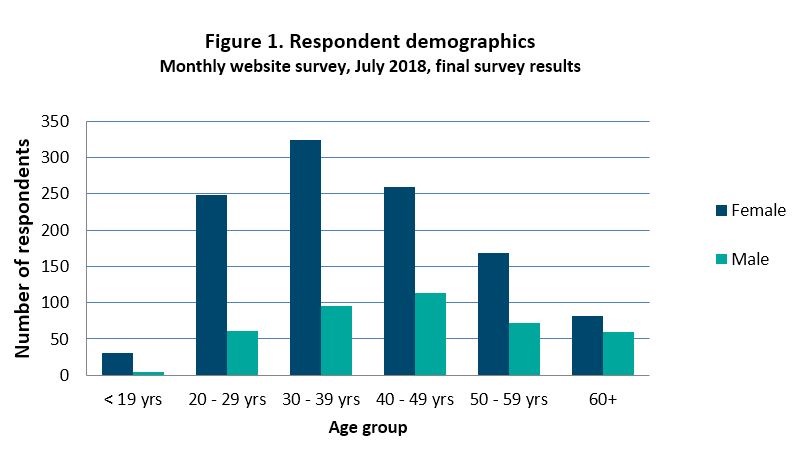
A substantial majority of men and women reported that they are always or sometimes able to recognise when their own mental health is poor. Slightly more women (43%) than men (36%) reported that they could always recognise when their mental health is poor (Figure 2).
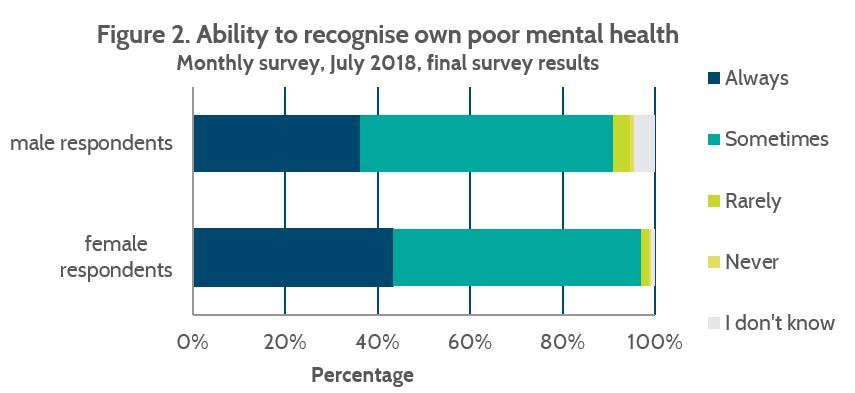
The majority of both men (87%) and women (93%) reported that they were always or sometimes able to recognise if others around them, such as family members or their partner, were suffering mental ill-health (Figure 3).
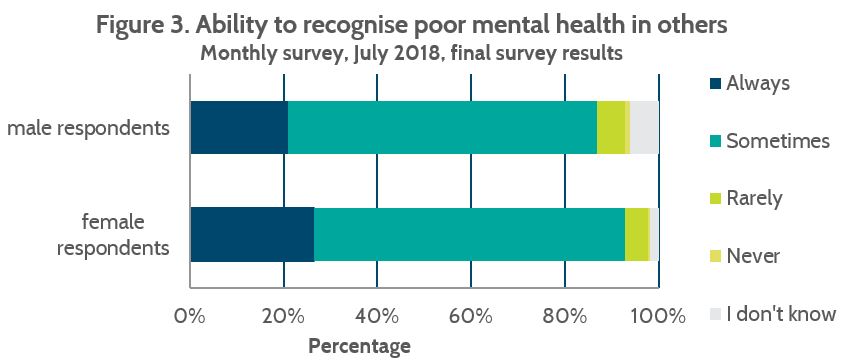
As shown in Figure 4, eighty-six per cent of women responded that they always or sometimes find mental health services useful. Fewer men (76%) responded that mental health services are always or sometimes useful. Ten per cent of male respondents reported that mental health support services are rarely useful.
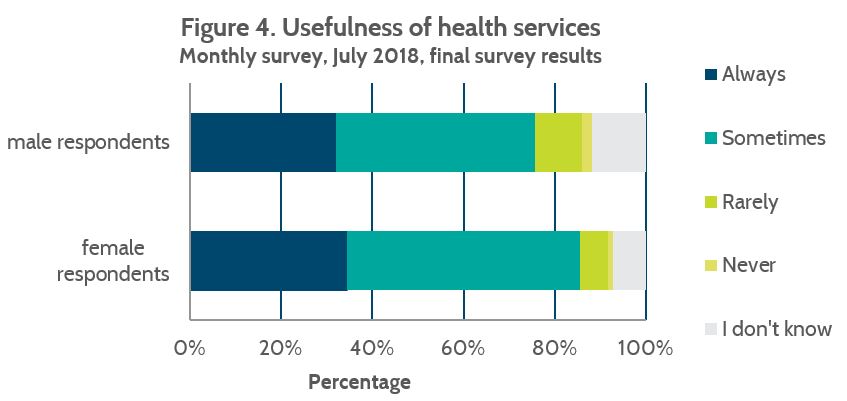
As shown in Figure 5, two-thirds (66%) of women and fifty-five per cent of men reported that they would know where to go to access support for themselves or their partner’s mental health. One quarter of men (25%) reported that they do not know where to get mental health support, which was more than that reported by women (15%) (Figure 5).
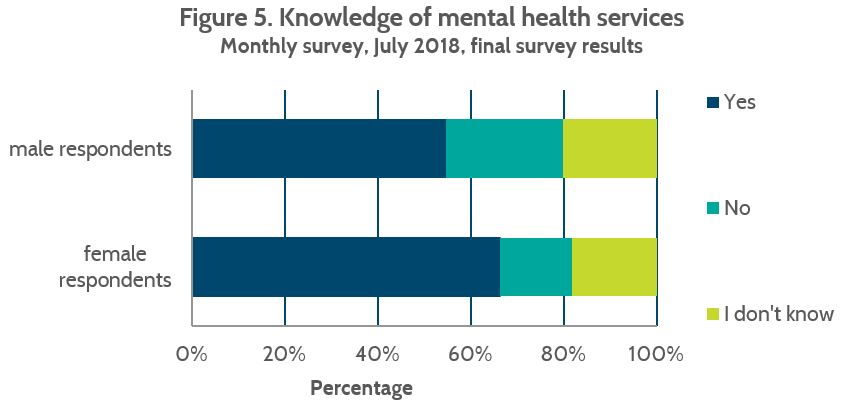
More women (41%) than men (32%) reported that they can sometimes afford mental health support. Just under one third (32%) of women, and thirty per cent of men, responded that they can rarely or never afford mental health support if/when they need it (Figure 6).
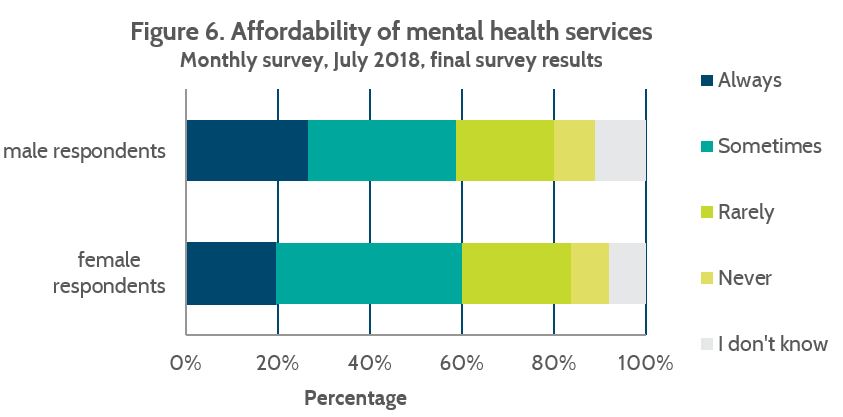
Finally, respondents were asked whether they would prefer to use online mental health support platforms (such as the ‘headspace’ app), over other forms (such as seeing a counsellor or doctor in person) (Figure 7). Around one-third of both women (32%) and men (33%) reported that they do not prefer to use online mental health services over other, in-person forms of support. Just over half of female respondents (52%) and forty-five per cent of male respondents stated they would prefer to use more than one form of mental health support.
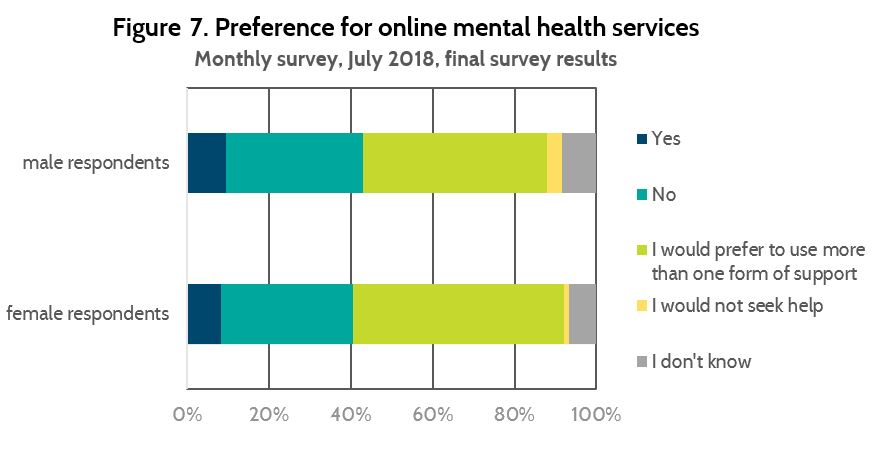
References
Australian Bureau of Statistics. (2008). National Survey of Mental Health and Wellbeing: Summary of Results, 2007. Cat. no. (4326.0). Canberra: ABS.
Australian Institute of Health and Welfare. (2018), Mental Health Services in Australia. Report. https://www.aihw.gov.au/reports/mental-health-services/mental-health-services-in-australia/report-contents/summary
Kauer, S. D., Mangan, C., & Sanci, L. (2014). Do Online Mental Health Services Improve Help-Seeking for Young People? A Systematic Review. Journal of Medical Internet Research, 16(3), e66. http://doi.org/10.2196/jmir.3103
World Health Organization. (2017). Mental Health Atlas. Online publication. http://apps.who.int/iris/bitstream/handle/10665/272735/9789241514019-eng.pdf?ua=1
https://www.blackdoginstitute.org.au/docs/default-source/factsheets/facts_figures.pdf?sfvrsn=8
https://www.healthdirect.gov.au/symptoms-of-mental-illness
Where to get help
Despite increased awareness of mental health issues in the community, suicide is the leading cause of death for young people aged 15-24 years in Australia.
According to Suicide Prevention Australia, suicidal thoughts and behaviour are connected to a range of social, personal and contextual risk factors, such as socio-economic disadvantage, bullying and social exclusion, sexual identity and childhood adversity. Young people may think about suicide because of difficult things that may have happened in their past, things currently going on in their lives that they may be having trouble coping with, how connected and supported they feel, and how they feel in terms of their self-worth and life outlook. Mental health conditions such as depression or anxiety and stressful life events like exams or going through a relationship breakup can also contribute to suicidal thoughts in young people.
Below are some ideas and contact details for services that may help you if you, or someone you know, are thinking about or has attempted suicide.
If you are feeling unsafe right NOW, call the Police on 000.
If you would like to talk to someone you can contact one or more of the services below. You don’t have to provide your name or personal details:
- Kid’s Helpline: information is available at www.kidshelpline.com.au or by calling 1800 55 1800.
- Lifeline: information is available at www.lifeline.org.au or by calling 13 11 14.
- SANE Australia: information is available at www.sane.org or by calling 1800 18 7263.
- Suicide Call Back Service: information is available at www.suicidecallbackservice.org.au or by calling 1300 659 467.
- Youth Beyond Blue: information is available at www.youthbeyondblue.com or by calling 1300 22 4636.
- Black Dog Institute: information is available at www.blackdoginstitute.org.au or by calling 02 9382 4530.
- Mensline Australia: information is available at www.mensline.org.au or by calling 1300 78 99 78.
- National Sexual Assault, Domestic and Family Violence Counselling Service: information is available at www.1800respect.org.au or by calling 1800 737 732, 24-hours a day, seven days a week.
- Translating and Interpreting Service: 13 14 50.
- National Relay Service: 133 677.
